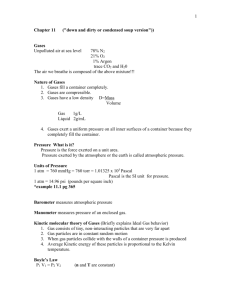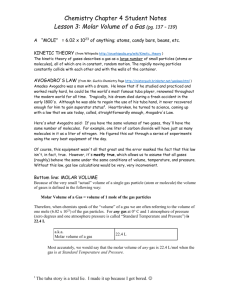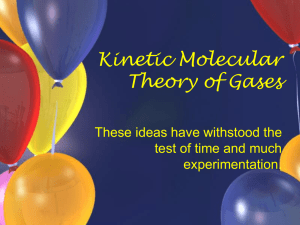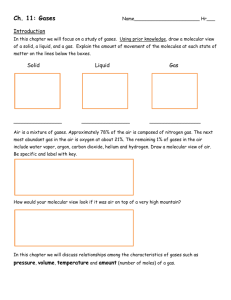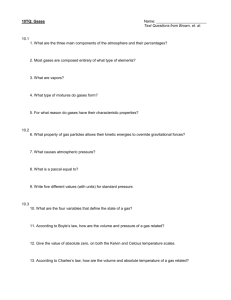Kinetic Molecular Theory
advertisement
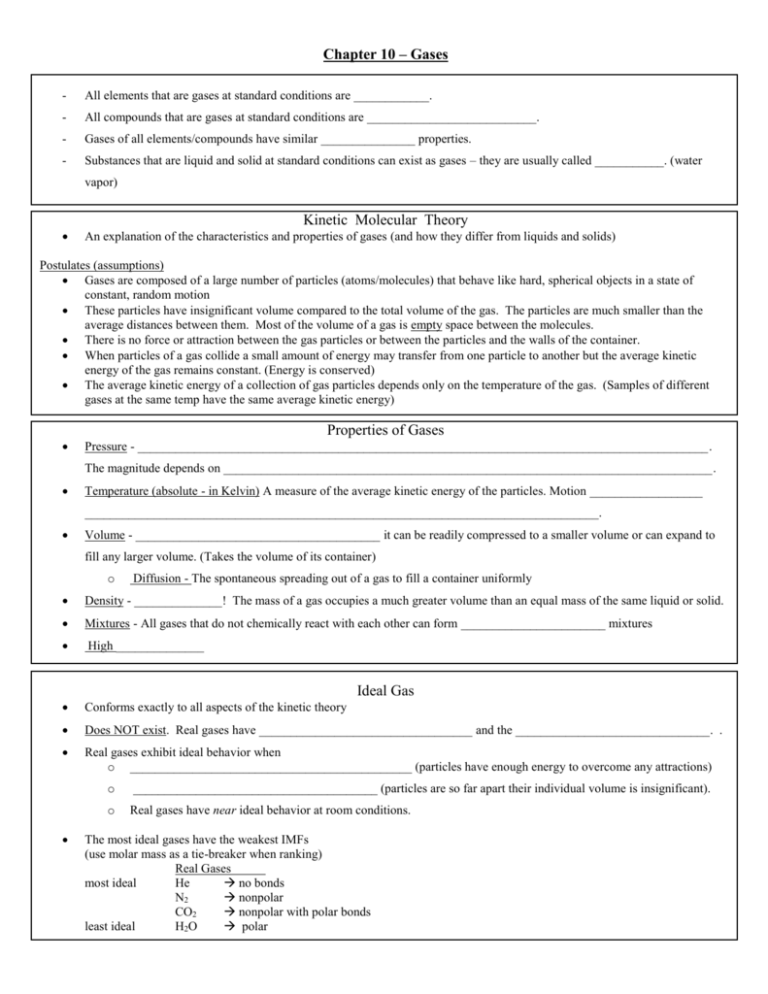
Chapter 10 – Gases - All elements that are gases at standard conditions are ____________. - All compounds that are gases at standard conditions are ___________________________. - Gases of all elements/compounds have similar _______________ properties. - Substances that are liquid and solid at standard conditions can exist as gases – they are usually called ___________. (water vapor) Kinetic Molecular Theory An explanation of the characteristics and properties of gases (and how they differ from liquids and solids) Postulates (assumptions) Gases are composed of a large number of particles (atoms/molecules) that behave like hard, spherical objects in a state of constant, random motion These particles have insignificant volume compared to the total volume of the gas. The particles are much smaller than the average distances between them. Most of the volume of a gas is empty space between the molecules. There is no force or attraction between the gas particles or between the particles and the walls of the container. When particles of a gas collide a small amount of energy may transfer from one particle to another but the average kinetic energy of the gas remains constant. (Energy is conserved) The average kinetic energy of a collection of gas particles depends only on the temperature of the gas. (Samples of different gases at the same temp have the same average kinetic energy) Properties of Gases Pressure - ___________________________________________________________________________________________. The magnitude depends on ______________________________________________________________________________. Temperature (absolute - in Kelvin) A measure of the average kinetic energy of the particles. Motion __________________ __________________________________________________________________________________. Volume - _______________________________________ it can be readily compressed to a smaller volume or can expand to fill any larger volume. (Takes the volume of its container) o Diffusion - The spontaneous spreading out of a gas to fill a container uniformly Density - ______________! The mass of a gas occupies a much greater volume than an equal mass of the same liquid or solid. Mixtures - All gases that do not chemically react with each other can form _______________________ mixtures High ______________ Conforms exactly to all aspects of the kinetic theory Does NOT exist. Real gases have __________________________________ and the _______________________________. . Real gases exhibit ideal behavior when o _____________________________________________ (particles have enough energy to overcome any attractions) Ideal Gas o _______________________________________ (particles are so far apart their individual volume is insignificant). o Real gases have near ideal behavior at room conditions. The most ideal gases have the weakest IMFs (use molar mass as a tie-breaker when ranking) Real Gases most ideal He no bonds N2 nonpolar CO2 nonpolar with polar bonds least ideal H2O polar Pressure Gas pressure is due to _____________________________________________________________________________. Pressure = Units are: lb/in2 (psi), g/cm2, atmospheres (atm), mm Hg, Torr, pascals (Pa), kilopascals (kPa), bar Unit relationships (used for converting units) o 1.00 mm Hg = 13.6 mm H2O o 1 mm Hg = 1 Torr o 1 atm = 760 mm Hg o 1.00 atm = 14.7 lb/in2 o 1.00 atm = 1.01 105 Pa Measuring Pressure Principle: Pressure on a gas = pressure of a gas Eudiometer: gas measuring tube Manometer: instrument which allows for the determination of the pressure of a gas sample Barometer: instrument for measuring air pressure STP Standard Temperature a reference temperature which is _________________________ NOT the same as standard state (25oC or 298 K) Standard Pressure a reference pressure which is ___________________________ Molar Volume of a gas The volume of 1 mole of a gas at standard temperature and pressure (STP) __________________________ (at 273 K and 1 atm) Boyle’s Law Gas Pressure vs. Gas Volume As the container size decreases, the particles collide with the walls more frequently thus raising the pressure qualitatively: P ↑ , V ↓ or P↓ , V ↑ temperature and moles held constant Boyle's Law: P V = k for a given amount at constant temp if P1V1 = k and P2V2 = k then Represents an inverse variation Amonton’s Law (Not in your book) Gas Pressure vs. Gas Temperature Increasing the temperature increases the KE of the molecules. With higher velocities, the molecules hit the walls more often and harder: more pressure (if volume held constant) qualitatively: T ↑ , P ↑ or T↓ , P ↓ volume and moles held constant Amonton's Law: Represents a direct variation: graph is a straight line to get zero pressure, temperature must be zero Kelvin (absolute zero) T =k P P ONLY if temp is Kelvin, V and moles held const. Charles’s Law Gas Volume vs. Gas Temperature Increasing the temperature increases the KE of the molecules. The faster moving molecules will hit the walls more often and harder. If the pressure is held constant and the volume is not, the volume will increase. qualitatively: T ↑ , V ↑ or T ↓ , V ↓ pressure and moles held constant Charles' Law: direct variation: graph is a straight line to get zero volume, temperature must be zero Kelvin This law combines Boyle’s, Amonton’s and Charles’s Laws into one law. It allows you to do calculations for situations in which only the amount of gas is constant T =k V Temp in Kelvin, P and moles held constant Combined Gas Law (Not in your book) P1V1 = P2V2 P1T2 = P2T1 V1T2 = V2T1 If you remember only this one equation – you should be able to derive all 3 of the gas laws! Law of Combining Volumes Gay-Lussac: Gas volumes during a chemical reaction are proportional to the coefficients of the balanced equation. 2 H2(g) + O2(g) 2H2O(g) 2L + 1L = 2 L Avogadro’s Hypothesis Avogadro used Gay-Lussac’s work and realized: Equal volumes of gases at the same temperature and pressure contain equal numbers of molecules. (it doesn’t matter what gas it is – H2, H2O, CO2, etc) o Ex: 22.4L of any gas at 273K and 1atm contains 6.02x10 23 particles (1 mole). Avogadro’s Law Gas Volume vs. Amount of Gas Increasing number of molecules will increase collisions and will increase volume if pressure is held constant qualitatively: n ↑ , V ↑ or n ↓ , V ↓ Avogadro's Law: V =k n P and T held constant Rearranging we get: So volume and mole ratios are equivalent to one another! Ideal Gas Law Combines all of the above into one equation or relationship o o o o o P is pressure V is volume n is the number of moles of gas T is the temperature in KELVIN R is the universal gas constant Value of the Gas Constant (R) PV (1.00 atm)(22.4 L) L atm = = 0.0821 nT (1.00 mole)(273 K) mole K R = other values of R o 1.987 cal/mol K o 8.314 J/mol K o 8.314 m3 Pa/mol K o 62.36 L torr/mol K ____________________________________________ when using this equation! Other Applications of the Ideal Gas Law The ideal gas equation can be stated in other ways incorporating other variables while still keeping the same general relationship o g is grams o D is density o mm is molar mass o van der Waals Equation (Ideal vs. Real Gases) Corrects the ideal gas equation for the "problems" of real gases o ___________________________________________________________________________________________ o ___________________________________________________________________________________________ your textbook has a chart of van der Waals constants (a and b) for several common real gases on page 412 Dalton's Law of Partial Pressure Total number of collisions is based on total number of molecules. Collisions from one kind of gas molecule are based only on that kind of molecule. The total pressure of a mixture of gases is the sum of the pressures of each individual gas (each gas is said to have a partial pressure) Dalton's Law can be stated in a slightly different way emphasizing one component of the gas mixture the ratio ngas 1 / ntotal is called the "mole fraction" of the gas and is symbolized by X gas 1 substituting in the above equation we get: Dalton’s Law Application #1 Dalton’s Law Application #2 especially useful when collecting a gas by water displacement 1. a gas collected by water displacement will have some water vapor mixed in with the gas 2. since we want only the pressure of the gas: 3. values for water vapor pressure are in Appendix B (pg. 1058) of your text Graham's Law Related to the rate at which gases: o diffuse _____________________________________________________________________ o effuse ______________________________________________________________________ Lighter particles (low MM) move faster! most often stated as: can also use density: Root-mean-square (rms) speed The speed (velocity) of molecules with exactly the average kinetic energy o KE= ½ mv2 o Some molecules in a gas sample move faster o Some molecules in a gas move slower o rms speed is close to the average speed o Temperature is related to the average kinetic energy of the sample as temperature increases, rms speed increases. Root mean square (rms) speed (symbolized by ) rms speed () decreases with increasing molar mass (heavier particles move slower!) Chapter 10 Book HW: Part #1 – 10(12, 16, 22, 26, 28, 32, 40,44, 46, 48, 94) Due Friday 1/25 Part #2 – 10(7, 10, 52, 56, 58, 60, 64, 66, 74, 84) Due Monday 1/28 Mon 1/28 – Gas Quiz #1 Tues 1/29 – Gas Lab Wed 1/20 – Gas Quiz #2 Thurs 1/21 – AP Question WS Due Fri 1/22 – Gas Test ----------------------------------------------------------------------------------------------------------------------------- ----------General Plan for 2nd Semester: Chapter 10 – Gases Chapter 11, 12(ish), 13 – Liquids, Solids, Solutions Chapter 14 – Kinetics Chapter 15 – Equilibrium Chapter 16 – Acid/Base Equilibrium Spring Break Chapter 17 – More Equilibrium Final Exam May 6th 8:00AM – AP Chemistry Exam Special Topics (organic, labs, etc.) Test over Special Topics during final exam week
